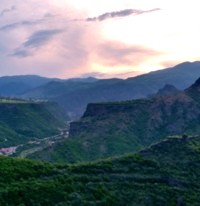The Silk Road
Human activities in these mountains might have remained very basic: housed in primitive stone structures; clothed in hides; using stone tools; weaving; and tending herds; were it not for a wealth of mineral resources, including deposits of copper, that became essential to the manufacture of humanity's first industrial; engineering; and weapon making metal: bronze.
This is among the oldest bronze making regions in the world. Thus, over three millennia before the Common Era (> 3,500 BC), metallurgy and industrial science blossomed here and made the region attractive to a succession of imperial conquerors.
Later its geographical position, astride one of ancient humanity's most important trade routes added to its strategic importance. This ancient trade route came to be known to modern historians as the Silk Road, because it connected the Mediterranean and later European civilisations to the silks of China. Trade is of course a two way arrangement. In return China probably acquired bronze technology.
As my earlier travelogue: 'In the footsteps of Marco Polo' describes there was no actual 'silk road' but a series of cities; towns; and caravanserai, that traders and merchants travelled between, like a 'bucket brigade' using stepping stones across a stream.
Very seldom did anyone, as did Marco Polo, traverse the entire distance from Beijing or Xi'an to the Mediterranean. And just like using randomly convenient stepping stones, there were a number of different routes: depending on the prevailing difficulty and/or the experience of the traders. Preference might also be given to places that added value to the trade with local craftsmanship: weaving, potting or smelting metals. Among these stops along the way were the centres that are now: Ürümqi in China; Khujand in Tajikistan; and Tashkent, Samarkand, Bukhara and Khiva in Uzbekistan.
Each of these has a chapter in: In the footsteps of Marco Polo. Read more...
Although most silk trade went around, after leaving Khiva or Bukhara, a trader could also travel to one of several small ports on the Caspian Sea and catch a boat. The remains of ancient trade goods and settlements, long ago lost to climate change, have been found around Aktau on the eastern shore.
Another important silk road stepping stone, until it was destroyed by the Mongols in the 13th century, was the ancient city of Konjikala. It afforded a sometimes safer route to the south of the Caspian that avoided the unpredictable, slave trading, city of Khiva. Konjikala was later restored, under the Russian Empire, as Ashgabat, to become the capital of Turkmenistan.
In 1948, eighteen years before the Tashkent earthquake, Ashgabat suffered a similar earthquake and too was rebuilt as a modern Soviet capital. I haven't been to Turkmenistan but Ashgabat's on-line panorama looks familiar - quite like Tashkent. See here...
The port city of Baku was an almost inevitable next stop, after which the ancient trade route continued overland, across the Caucasus, traversing the Darial Gorge, and/or other passes in Georgia, to the Roman constructed deep water port of Batumi, on the Black Sea. From there traders could travel directly by ship to Byzantium (Constantinople/Istanbul) then on to Venice; Athens; Rome or perhaps, even, up the Nile.
Stepping stones on the Silk Road
Khiva was not always friendly to passing caravans Read more...
The Caucasian route gained added importance in the 6th century as a result of the confrontation between the Byzantine and Persian Empires - when it became difficult and unprofitable to carry silk to Byzantium and the Mediterranean via Persia. An ancient record confirms that least one caravan loaded with silk used this route in 568 CE, after which it appears to have become the preferred route for at least a century. Archaeological excavations in the North Caucasus confirm that in the late 6th century and the first half of the 7th century the greater part of Chinese silk was delivered to Byzantium through the Caucasus. But this changed after the Arab invasion when a less arduous route, via Persia, again became competitive.

